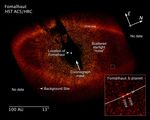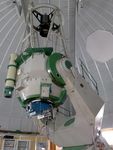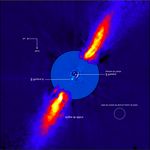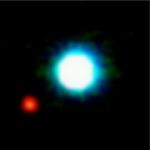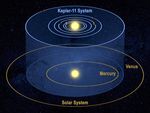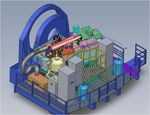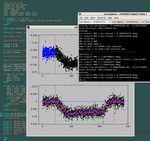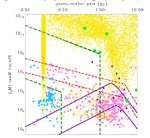Exosolar Planet Research in Italy 2011 - Raffaele Gratton INAF - Osservatorio Astronomico di Padova
←
→
Page content transcription
If your browser does not render page correctly, please read the page content below
Exosolar Planet Research in
Italy - 2011
Raffaele Gratton
INAF – Osservatorio Astronomico
di Padova
Palermo, Meeting on PLATO, May
2-3, 2011SUMMARY
• Current research • Future research
– SARG: exoplanets in visual – SPHERE (2012)
binaries – HARPS-N (2012)
– Ground based Transit – Giano (2012)
programs – GAIA (2012-2017)
– Timing programs – Espresso (2015)
– NACO Large Program – PLATO (2019?)
– Microlensing – EPICS (>2020)
– Characterizing exoplanet – SIMPLE (>2020)
hosts
– CODEX (>2020)
– Dynamics of exoplanet
systems – EChO (>2020)
Palermo, Meeting on PLATO, May
2-3, 2011Web site (I. Pagano, OACT)
• http://www.oact.inaf.it/exoit/Projects/Projects.html
Palermo, Meeting on PLATO, May
2-3, 2011PRIN INAF
• PRIN INAF 2008: “Environmental effects
in the formation and evolution of extrasolar
planetary systems”, PI N. Lanza (OACT)
– UdR: OACT/OAPD/OAPA/OATO
• PRIN INAF 2010: “Planetary system at
young ages and the interactions with their
active host stars”, PI S. Desidera (OAPD)
– UdR: OAPD/OACT/OAPA/OATO
Palermo, Meeting on PLATO, May
2-3, 2011SARG: exoplanets in visual
binaries
• Team involved: PI: Desidera (OAPD), OACT,
TNG
• Survey of ~100 nearly twins in visual binaries
• Results:
– No composition difference between components
– Low frequency of planets in systems with separationsGround based Transit programs
• Individuals involved in very successful
surveys (WASP, TrES, Corot)
• Italian programs:
– Transits in clusters: Univ. PD, OAPD
– M-dwarf: Oss. Valle d’Aosta, OATO
– TASTE (transiting time variations): Univ. PD
– Follow-up
• Rossiter effect (OAPD)
• Spectroscopy (OATO)
Palermo, Meeting on PLATO, May
2-3, 2011The TASTE project
By performing accurate timings of exoplanet
transits, it is possible to detect deviations from a
linear ephemeris. From these transit-time
variations (TTVs), one can test for the presence
of a third, perturbing body in the system, and infer
its orbital period and mass.
The Asiago 1.82m telescope
This is so far the only technique able to discover and
characterize earth-mass planets (Kepler-11 6-planet system,
validated without RVs: see Lissauer et al. 2011).The TASTE project
Two years ago, a Padova-based group started a project
specifically designed to detect TTVs in a selected sample of
transiting systems. The project is called TASTE (The
Asiago Search for Transit-Time Variations of
Exoplanets; Nascimbeni et al. 2011, A&A 526, 85).
The TASTE team has implemented new,
independent software tools for the data
reduction and analysis.Started with the Asiago 1.82m, TASTE is now a multi-site
project:
Asiago 1.82m (large program, ~5 nights/month)
Asiago 67/92cm Schmidt (commissioning)
Carlos Sanchez Telescope, Teide Obs. (12 nights scheduled, 4
proposed)
IAC-80, Teide Obs. (10 nights scheduled, 9 proposed)
NOT, La Palma (4 nights proposed)
CTIO/SMARTS 0.90m, La Silla (7 nights proposed)
REM, La Silla (5 nights proposed)
.
On the Asiago 1.82m telescope, a
photometric precision of ~0.5 mmag and a
∼10-20 s timing accuracy for transits can be
achieved for most targets. That would be
sufficient for a ~10σ detection of a typical
resonant “earth”.
A first TTV candidate has been identified
(Nascimbeni et al. 2011B, submitted). More
observations will be collected by TASTE to
characterize unambiguously the perturber.Timing programs
• Team involved: OATo, OACN
• See presentation by Silvotti
Palermo, Meeting on PLATO, May
2-3, 2011NACO Large Program
• Team involved: OAPD, OACT, OACN
• High contrast imaging survey of ~150 nearby (d40 AU)
– Preparatory work for SPHERE
Palermo, Meeting on PLATO, May
2-3, 2011Angular differential imaging
Angular differential
imaging: take sequence of
images with the field
derotator switched off.
The field of view rotate
with respect to the
instrument, keeping the
optics aligned. This allow
to strongly reduce
instrumental artefacts.
Lafreniere et al. 2007NACO-LP: INAF role Target selection (S. Desidera) Contribution to data analysis (D. Mesa, R. Gratton, E. Carolo) Stellar properties (S. Desidera, E. Covino, A. Lanzafame, S. Messina) Statistical analysis (S. Desidera, R. Gratton, M. Bonavita) PRIN INAF 2010 based on NACO-LP
Microlensing
• Team involved: Un.
Lecce, Un. Salerno,
OABO
• Participation to survey
in the bulge
• Surveys for
microlensing events
in M31 using Loiano
and Toppo telescopes
Palermo, Meeting on PLATO, May
2-3, 2011Characterizing exoplanet hosts
• Team involved: OACT, OAPA, OAPD, OATO, OABrera
• Abundances in stars hosting planets
• Parameters in stars hosting planets
• Star-Planet interaction (Pagano et al. 2009; Lanza 2008,
2009)
• High energy fluxes on planetary atmospheres
• Magnetic activity of stars with planets
– Impact of activity on RVs (Bonomo & Lanza 2008; Lanza et al.
2008; Bonomo et al. 2009; Lanza et al. 2010)
– Corot stars (Lanza et al. 2009, 2010; Silva-Valio & Lanza 2011)
• Tidal evolution of stars with Hot Jupiters (Lanza et al.
2011)
• Angular momentum of stars with Hot Jupiters (Lanza
2010; Damiani & Lanza 2010)
Palermo, Meeting on PLATO, May
2-3, 2011Alcuni contributi per la
presentazione su “La ricerca
sugli esopianeti in Italia”
da parte di A. F. Lanza
INAF-Osservatorio di Catania
Palermo, Meeting on PLATO, May
2-3, 2011Principali temi di ricerca
• Metodi per ridurre gli effetti dell’attività magnetica stellare
sulla rivelazione dei transiti, le misure di velocità radiale e
le misure astrometriche (Bonomo & Lanza 2008; Lanza et
al. 2008; Bonomo et al. 2009; Lanza et al. 2010);
• Studio dell’attività magnetica e della rotazione in stelle con
pianeti scoperti da CoRoT (Lanza et al. 2009, 2010; Silva-
Valio & Lanza 2011);
• Osservazioni e teoria dell’interazione magnetica stella-
pianeta (Pagano et al. 2009; Lanza 2008, 2009);
• Evoluzione mareale di stelle con hot Jupiters (Lanza et al.
2011);
• Evoluzione del momento angolare in stelle con hot Jupiters
ed applicazioni alla gyrochronology (Lanza 2010; Damiani
& Lanza 2010).
Palermo, Meeting on PLATO, May
2-3, 2011Spot modelling di stelle con
pianeti scoperti da CoRoT
• Le curve di luce di CoRoT consentono di
ottenere mappe della distribuzione delle regioni
attive in fotosfera in funzione della longitudine e
del tempo;
• Dalla migrazione delle longitudini attive si puo’
ottenere un limite inferiore per la rotazione
differenziale;
• Viene presentato il caso di CoRoT-6 (Lanza et
al. 2011, A&A 525, A14) per la quale
ΔΩ/Ω=0.12 ± 0.02.
Palermo, Meeting on PLATO, May
2-3, 2011Lanza et al. 2011, A&A 525, A14:
CoRoT-6 ΔΩ/Ω=0.12 ± 0.02
Palermo, Meeting on PLATO, May
2-3, 2011NACO LP/SPHERE GTO: Stellar Characterization Characterization of late type stars in charge to INAF Padova: S. Desidera, V. D'Orazi Napoli: E. Covino, J. Alcala', K. Biazzo Catania: S. Messina, A. Lanzafame, E. Brugaletta Rotational period: from ASAS, Super WASP and other archives Spectroscopic characterization: FEROS and HARPS spectra (SPHERE prep. Obs. + archives) Age determination (improving age calibrations in progress)
Rotation period and
system inclination
Rotation period determined
from ASAS photometry
Projected rotational velocity
from spectra
Stellar radius from L and Teff
Star seen nearly edge-on, no
indication for non-coplanarity
with the disk
Marley et al. 2007 Desidera et al. 2011Li and rotation Slow rotators have lower lithium content at fixed age Desidera et al. 2011
Dynamics of exoplanet systems
• Team involved: Un. Padova
• Results: 7 papers published in the last two
years
Palermo, Meeting on PLATO, May
2-3, 2011Palermo, Meeting on PLATO, May
2-3, 2011Future research
Palermo, Meeting on PLATO, May
2-3, 2011SPHERE (PI: J.L. Beuzit, LAOG)
• High contrast imager for VLT
• Team involved: Co-I: M. Turatto (OATS), IFS
team (OAPD, OACT, OACN, IFSI-Milano), INS
(OAPD)
• Performance: contrast 107 at >0.1 arcsec
• Detection and characterization of young giant
planets (20 AU)
• Operation: 2012
• GTO: 260 nights over 5 years
Palermo, Meeting on PLATO, May
2-3, 2011SPHERE Consortium
LAOG (PI), MPIA, LAM, ONERA, LESIA, INAF, ETH-
Zurich, Geneva Obs., LUAN, ASTRON, UvA, ESO
INAF role in SPHERE
Responsible for the IFS channel (the most promising in terms of
contrast and planet detection) (resp. M.Turatto & R. Claudi)
Responsible for instrument software (resp. A. Baruffolo)
Leading role in the science group and in the preparation of the GTO
survey (260 VLT nights) (resp. R. Gratton & S. Desidera)
Involved INAF institues: Padova, Catania, Napoli, Milano
Schedule:
Commissioning: late 2012
Science operations: 2013Palermo, Meeting on PLATO, May
2-3, 2011SPHERE concept The very challenging science goal of direct detection of planets requires a fully optimized instrument Extreme adaptive optics Coronagraphy Differential imaging to remove speckle noise: three instruments optimized for different types of planets (young, self-luminous planets, old planets shining in reflected light) IFS: spectral differential imaging Y-J-H bands (best contrast) IRDIS: differential imaging in H band over a wide field ZIMPOL: differential polarimetry in R-I bands for detection of reflected light Dedicated instrument modes for planet characterization
Science objectives
High contrast imaging down to planetary masses
Investigate large target sample: statistics, variety of
stellar classes, evolutionary trends
Complete the accessible period window
First order characterization of the atmosphere (clouds,
dust content, Methane, water absorption, effective
temperature, radius, dust polarization)
Understand the planetary system originsSPHERE GTO Survey 260 GTO nights to compensate manpower and funding by the SPHERE Consortium GTO organized at Consortium level Homogeneous NIR survey using simultaneously IFS in Y-J bands and IRDIS in H band (at least 200 nights) Leading role of INAF in the survey preparation Sample of about 400 stars younger than 1 Gyr divided in bins of different mass and age + stars with RV signatures (planets are brighter at young ages and then nearby young stars are the best targets for planet detection)
EPICS (PI M. Kasper, ESO)
• High contrast imager for E-ELT
• Team involved: IS: Gratton (OAPD)
• Performance: contrast 109 at >0.03 arcsec
• Detection and characterization of:
– young planets (2020
Palermo, Meeting on PLATO, May
2-3, 2011EPICS:
a planet finder for E-ELT
Consortium:
ESO (PI), LAOG, LAM, LESIA, LUAN,
Oxford Un., INAF-OAPD, ETH Zur.
Science goals
Detection of giant planets in star-forming regions
Detection of mature giant planets (reflected light),
including planets detected by radial velocity
Physical characterization of giant planets
Detection of Neptune and Earth-mass planets around
nearby stars
Schedule: on sky > 2020RV signal of detectable
planets
Very strong synergy between RV and EPICS2 baseline instruments 1. Integral Field 2. Differential Spectrograph polarimeter • Y-H • 600-900 nm • R ~50-100 • FoV ~2 arcsec • FoV ~2 arcsec • Achromatic • Data cube • Temporal modulation • Trade-off slicer vs • (Close to) zero lenslets differential (FP7 breadboards) aberrations
HARPS-N
• High precision RV spectrometer for TNG
(0.37-0.7 µm)
• Team involved: Co-PI E. Molinari (TNG)
co-I G. Piotto (Un. PD), G. Micela (OAPA), A.
Sozzetti (OATO)
• Follow-up of Kepler; detection of planets down to
a few Earth masses
• Operation: 2012
• Consortium: 60 nights/year
• Talk by R. Claudi
Palermo, Meeting on PLATO, May
2-3, 2011• HARPS-N will likely be the best instrument
worldwide for high precision radial velocities in
the next five years.
• With HARPS-N, TNG will be highly competitive
for the quest for extra-solar planets, down to
Earth-like masses, and asteroseismology.
• HARPS-N is likely to play a basic role in the
scientific exploitation of data from other
instruments like KEPLER, GAIA, SPHERE-GPI,
and in a farther perspective, PLATO and EPICS.
• In addition, the groups having a vast experience
in use of HARPS-N will have a clear advantage
in the use of future highly performing facilities
like ESPRESSO and CODEX.
Palermo, Meeting on PLATO, May
2-3, 2011Palermo, Meeting on PLATO, May
2-3, 2011Palermo, Meeting on PLATO, May
2-3, 2011Giano (PI L. Origlia)
• NIR High resolution spectrograph for TNG
(0.9-2.3 µm)
• Team involved: PI: L. Origlia (OABO) IS:
T. Oliva (OAArcetri)
• Detection of planets around M-stars;
characterization of transiting planets
• Operation: 2012
• See talk by L. Origlia
Palermo, Meeting on PLATO, May
2-3, 2011SIMPLE (PI L. Origlia)
• NIR High resolution spectrograph for E-
ELT (0.9-2.3 µm)
• Team involved: PI: L. Origlia (OABO) IS:
T. Oliva (OAArcetri)
• Detection of planets around M-stars;
characterization of transiting planets
• Operation: >2020
• See talk by L. Origlia
Palermo, Meeting on PLATO, May
2-3, 2011Espresso (PI L. Pasquini, ESO)
• High precision RV spectrometer for VLT
• Co-I: OATS, OABrera
• Science: detection of rocky planets
• Operation: 2015
Palermo, Meeting on PLATO, May
2-3, 2011Codex (PI L. Pasquini, ESO)
• High precision RV spectrometer for E-ELT
• Co-I: OATS
• Science: detection of rocky planets
• Operation: >2020
Palermo, Meeting on PLATO, May
2-3, 2011GAIA (ESA)
• Italian involvement
(extrasolar planets):
OATO
• Operation:
2012-2017
See talk by
A. Sozzetti
Palermo, Meeting on PLATO, May
2-3, 2011PLATO (PI Català, Obs. Paris)
• Described in many talks of this meeting
• Italian involvement: OAPA, OACT, OAPD,
OABrera, Univ. Padova
• Operation: >2018-2020
Palermo, Meeting on PLATO, May
2-3, 2011EChO (PI G. Tinetti, UCL)
• Italian involvement: Co-I Micela (OAPA), IFSI-
RM, Un. Firenze, OATO
• EChO will be a 1.2 m telescope, orbiting around
the L2 Lagrange point, 1.5 million km from Earth
in the anti-sunward direction
• EChO will provide mid to high resolution, multi-
wavelength spectroscopic observations in the
wavelength range 0.6-16 µm of the combined
star and planet light
• Operation: 2020-2022
Palermo, Meeting on PLATO, May
2-3, 2011EChO
The Exoplanet Characterization Observatory
Selected by ESA for the assessment phase for a possible
launch in 2020-2022
EChO will be the first dedicated mission to study the
atmospheres of exoplanets: atmospheric composition,
temperature stratification, albedo, climate and
Dynamics,…
through differential measurements in and out primary
and secondary transits
It will place the Solar System in context
It will address: Diversity, Habitability, Atmosphere
evolution, Interaction star – planet
Palermo, Meeting on PLATO, May
2-3, 2011Scientific requirements
• Spectroscopy from ~0.4 to 16 micron,
• Contrast 10-5 (VIS, NIR, MIR, LIR)
• V Mag < 12 for G and K;
K Mag < 9/10 M-types
• 0.4-1 micron, R ≈ 600
• NIR-MIR (2-10 micron): R > 500
• LIR (8-16micron) R ≈ 300
Palermo, Meeting on PLATO, May
2-3, 2011Italian Scientific
Contribution
• Target list selection, critical for the success of the
mission (OAPa, OAPd, OATo) – PLATO & HARPS-N
role
• Solid expertise in solar system planetary atmospheres,
to be used as a template for exoplanetary science (IFSI)
• Synergy with Gaia and other ground instrumentation
(OATo, OaPa, OApd)
• Stellar physics, relevant for the planetary signal
extraction and for understanding star-planet interaction
(OAPa, OACt)
Palermo, Meeting on PLATO, May
2-3, 2011Italian Contribution
to the Payload
• EChO Visual Channel and Fine Guidance System
(EViGuS)
• On Board Data Handling system
• (Telescope)
• Proposing Team : INAF,( IFSI, Rome, IASF, Rome,
Palermo Observatory), Universita’ di Firenze
Palermo, Meeting on PLATO, May
2-3, 2011You can also read

